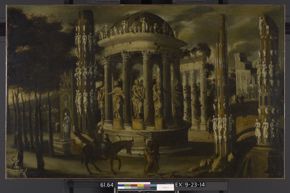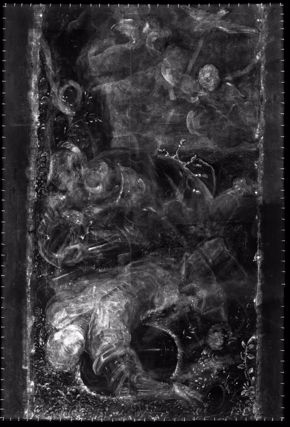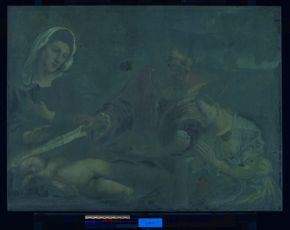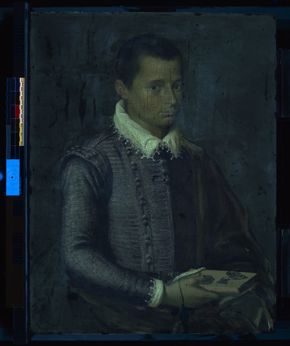Research Highlight: Samuel H. Kress Collection
Inspired by the Kress Foundation's initiative to improve awareness and access to paintings, the MFAH conservation department initiated technical studies of the 26 paintings in the Kress Collection.
The project benefited from the efforts of the 2015 Kress fellow in conservation, Samantha Skelton, who investigated and described the original materials of several of the paintings. The technical imaging (record photography, infrared reflectography and ultraviolet images, x-radiography) was undertaken by Matthew Golden, conservation imaging specialist; and Bertram Samples, senior paintings conservation technician. Scientific analysis of the materials of the Kress paintings and their ageing characteristics was undertaken by Corina Rogge, the Andrew W. Mellon research scientist at the MFAH and Menil Collection.
The goal of this ongoing project is to provide technical study reports on all the Kress paintings in the MFAH collection. As each report is completed, it will be posted online to allow free access to anyone interested in the historical methods, materials, and techniques of master artists of the past.
Alessandro Magnasco, “Figures in a Landscape” and “Landscape with Washerwomen”

Landscape with Figures in normal light.
Alessandro Magnasco, Landscape with Figures, c. 1715, oil on canvas, the Museum of Fine Arts, Houston, Samuel H. Kress Collection.
Ultraviolet fluorescence of Landscape with Figures by Alessandro Magnasco.
Verso of Landscape with Washerwomen by Alessandro Magnasco in normal light.
Verso of Landscape with Figures by Alessandro Magnasco in normal light.
Ultraviolet fluorescence of Landscape with Washerwomen by Alessandro Magnasco.
Landscape with Washerwomen by Alessandro Magnasco in normal light.
Alessandro Magnasco, Landscape with Washerwomen, c. 1715, oil on canvas, the Museum of Fine Arts, Houston, Samuel H. Kress Collection.
Landscape with Washerwomen and Landscape with Figures came to the MFAH in 1961 as part of the Samuel H. Kress Foundation donation. Both landscapes were painted by Alessandro Magnasco in 1715, but they contrast in tone.
► Access the full technical report on Landscape with Washerwomen and Landscape with Figures
François de Nomé, “The Flight into Egypt”

The Flight into Egypt recto in normal light.
François de Nomé, The Flight into Egypt, no date, oil on canvas, the Museum of Fine Arts, Houston, the Samuel H. Kress Collection.
The Flight into Egypt verso in normal light.
The Flight into Egypt, x-radiography image captured with Pantak-Seifert x-ray tube at the following parameters: 25kV, 3 µA, 45 seconds, 40” distance from tube. Captured in 20 sections, composite image created in Adobe Photoshop CS6. Image digitally altered by the author to minimize the appearance of stretcher bars.
The Flight into Egypt, infrared reflectography image captured with an Osiris Infrared Imaging System (InGaAs array sensor) in six sections and composite image created in Adobe Photoshop CS6.
The Flight into Egypt, recto in longwave ultraviolet radiation.
The painting by François de Nomé shows the Holy Family on the flight into Egypt, traveling against a fantastic architectural backdrop before a landscape setting. The Flight into Egypt has undergone extensive restoration throughout its history which may have significantly altered its appearance and apparent quality.
Domenico Tintoretto, “Tancred Baptizing Clorinda”

Tancred Baptizing Clorinda, x-radiography image captured with Pantak-Seifert x-ray tube at the following parameters: 25kV, 3 µA, 45 seconds, 40” distance from tube. Captured in 20 sections, composite image created in Adobe Photoshop CS6. Image digitally altered to minimize the appearance of stretcher bars and enhance the contrast.
Tancred Baptizing Clorinda, recto in longwave ultraviolet radiation.
Tancred Baptizing Clorinda, recto in normal light.
Tancred Baptizing Clorinda, infrared reflectography image captured with an Osiris Infrared Imaging System (InGaAs array sensor) in six sections and composite image created in Adobe Photoshop CS6.
Tancred Baptizing Clorinda, verso in normal light.
Tancred Baptizing Clorinda is in stable condition. There is evidence of multiple past campaigns of restoration including lining, several cleanings, and repaired losses. Some surface wear is apparent in the foreground, but the painting surface is otherwise in good condition for a work of this age.
► Access the full technical report on Tancred Baptizing Clorinda
After Lorenzo Lotto, “The Holy Family with a Donatrix as Saint Catherine of Alexandria”

The Holy Family with a Donatrix as Saint Catherine of Alexandria, recto, longwave ultraviolet fluorescence.
After Lorenzo Lotto, The Holy Family with a Donatrix as Saint Catherine of Alexandria, c. 1540–45, oil on canvas, the Museum of Fine Arts, Houston, Samuel H. Kress Collection.
The Holy Family with a Donatrix as Saint Catherine of Alexandria, recto in normal light.
After Lorenzo Lotto, The Holy Family with a Donatrix as Saint Catherine of Alexandria, c. 1540–45, oil on canvas, the Museum of Fine Arts, Houston, Samuel H. Kress Collection.
The Holy Family with a Donatrix as Saint Catherine of Alexandria, verso in normal light.
The Holy Family with a Donatrix as Saint Catherine of Alexandria, recto detail of infrared reflectograph
The Holy Family with a Donatrix as Saint Catherine of Alexandria, x-radiograph of recto (inverted)
The Holy Family with a Donatrix as Saint Catherine of Alexandria shows the Holy Family in a landscape setting, with a kneeling female donor depicted as Saint Catherine. The painting has undergone extensive restoration throughout its history, which may have significantly altered the appearance and apparent quality.
► Access the full technical report on The Holy Family with a Donatrix as Saint Catherine of Alexandria
Italian, “Portrait of a Boy Holding a Book”

Portrait of a Boy Holding a Book, recto, longwave ultraviolet fluorescence.
Italian, Portrait of a Boy Holding a Book, 1560s, oil on wood, the Museum of Fine Arts, Houston, the Samuel H. Kress Collection.
Portrait of a Boy Holding a Book, recto in normal light.
Italian, Portrait of a Boy Holding a Book, 1560s, oil on wood, the Museum of Fine Arts, Houston, the Samuel H. Kress Collection.
Portrait of a Boy Holding a Book, verso in normal light.
Italian, Portrait of a Boy Holding a Book, 1560s, oil on wood, the Museum of Fine Arts, Houston, the Samuel H. Kress Collection.
Portrait of a Boy Holding a Book, recto infrared reflectograph.
Italian, Portrait of a Boy Holding a Book, 1560s, oil on wood, the Museum of Fine Arts, Houston, the Samuel H. Kress Collection.
Portrait of a Boy Holding a Book, x-radiograph of recto.
Italian, Portrait of a Boy Holding a Book, 1560s, oil on wood, the Museum of Fine Arts, Houston, the Samuel H. Kress Collection.
Portrait of a Boy Holding a Book entered the Kress Collection in 1930, when the painting was purchased from the Marchese Maresca Collection in Naples. The painting had been restored several times prior to its entry into the MFAH collections.
► Access the full technical report on The Portrait of a Boy Holding a Book
About the Kress Collection
Twenty-six European paintings in the collection of the Museum of Fine Arts, Houston, share a special history. These works were a remarkable gift to the MFAH from the Samuel H. Kress Foundation and they stand as a testament to the model of American cultural philanthropy exemplified by Samuel H. Kress and his incomparable legacy: a sense of public responsibility imposed upon great wealth, and a belief in the moral force of art. They enrich the collection and provide beautiful, outstanding examples of Italian painting for the Houston public.
In the years of the Great Depression, a touring exhibition of 50 pictures from Kress’s private collection introduced Italian art to an eager public in 24 American cities. Throughout the 1930s his gifts of art placed the first Old Master paintings on the walls of local museums in many parts of the country. By 1941, his role as a Founding Benefactor of the National Gallery of Art reaffirmed both the value of his collection and his constancy of purpose.
During and after World War II, Kress increased his collection by adding an extraordinary number of incomparable European masterpieces. Then, following rearrangement of the 34 Kress galleries at the National Gallery, a large quantity of museum-quality paintings became available for viewing elsewhere. This opportunity gave rise to a novel, generous, and logistically ambitious program that offered representative surveys of Italian art to selected museums across the country. Through this national program in art philanthropy, the Kress Foundation ultimately donated more than 700 Old Masters to regional museums during the 1950s, including the MFAH. The Kress Collection paintings acquired by the MFAH span the late 15th to early 19th century, with the majority from various Italian artistic centers during the 16th century.
